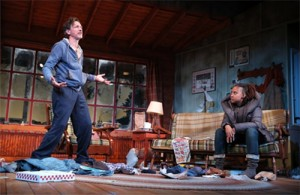By MARK BLANKENSHIP
There's no way to see the entire set of Lost Lake. A slightly surreal cabin in the woods, it's packed with so many objects that it would take hours to absorb them all. And besides, some elements are only visible to the actors---props and pictures tucked behind curtains or just past the edge of the stage.
But even if some of them are individually elusive, those details coalesce into a stage picture that feels instantly authentic. With just a glance, we can sense that, yes, a woman might rent this place for the week, trying to give herself and her children a break from life in New York City. A troubled man might live here his whole life, hiding from his mistakes until he decides to let the place to a stranger on holiday.
That believability is important to David Auburn's play, which is now at New York City Center's Stage I in a production from Manhattan Theatre Club. The characters---Veronica and Hogan---collide in unexpected ways during her vacation at his cabin, and to track the subtle shifts in their relationship, we need to feel intimately connected to their world.
"You never want to be taken out of the play," says set designer J. Michael Griggs, who also designed Lost Lake's first production at the University of Illinois earlier this year. "You never want to stop being involved with the characters."
Every detail, then, draws us more fully into the story. The old board game under the couch and the slightly crooked shutter lend weight to what we see.
Then there are details like a bowling scorecard on the refrigerator or the tiny "fireflies" that glow in the bushes outside---elements that only the actors are likely to observe. "Those are all little things I can do to keep them in the world," Griggs says.
Still, though, he's not trying to create a literal cabin. Parts of his design that are emotionally authentic, even if they don't make literal sense. For instance, at about the mid-point of the living room, one of the inside walls essentially turns into a shingle-covered outside wall. And the entire playing space is framed by yet another set of outside walls, only these are made of clapboard and covered in peeling paint.
Those strange distortions suggest the emotional turmoil in both Veronica and Hogan's lives, as well as how strangely they fit together as the play goes on.
Griggs realizes that those choices may only have a subconscious impact. "I know the audience isn't sitting there going, 'Why is that wall straight and that wall's crooked?'" he says. "But I hope it helps create a bit more tension in the space so that it doesn't all look comfortable and cozy. So that there seems to be something a little off."
He adds, "I don't see the point in making something completely realistic. If I can suggest some kind of atmosphere that wouldn't be there otherwise, I'd rather play with that."
---
Mark Blankenship is TDF's online content editor
Photo by Joan Marcus
